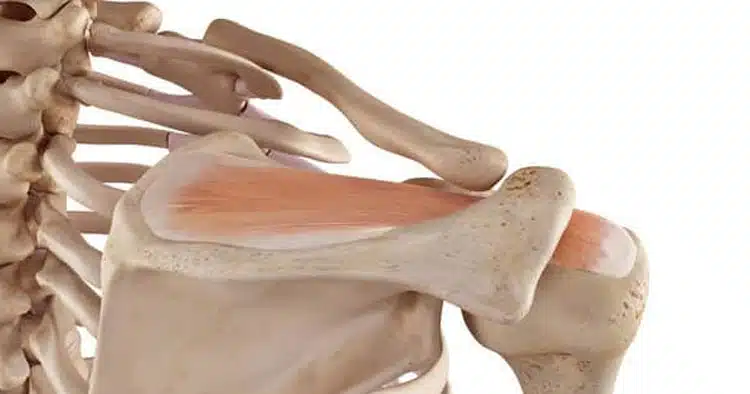Injury Rehabilitation and Training, Muscle Pain and Tendinopathy, Sports Injuries and Management
Rotator Cuff Impingement Syndrome Causes
Potential Causes Of Rotator Cuff Impingement Syndrome?
Rotator cuff impingement can be caused from a traumatic injury such as a fall, however it is repeated movement of your arm into the impingement zone overhead that most frequently causes rotator cuff impingement. When overhead movements are performed the rotator cuff gets trapped and pinched under the acromion (the part of the shoulder blade which forms a roof to the shoulder joint), with subsequent repetition of these actions the rotator cuff and/or bursa may become painful and swollen.
In a non-traumatic situation as described above meaning the onset of pain is not related to an accident, or the individual falling, but it is in turn caused through repeated actions. For this to occur, there are generally both structural, as well as postural & movement related causes in play.
Structural Causes Of Impingement
Primary causes of rotator cuff impingement refer to any structural factors that can play a role. Examples of potential structural factors include:
- Some individuals are simply born with a smaller sub-acromial space, or a hooked type acromion. Both of these situations are more likely to cause shoulder impingement.
- Conditions such as osteoarthritis can potentially lead to the development of subacromial bony spurs, spurs can further narrow the available space for the rotator cuff tendons allowing less room for them to pass freely.
As a result of any structural narrowing, an individual is more likely to pinch, squash, impinge, irritate soft tissues in the subacromial space. This irritation can result in bursitis, or rotator cuff tendinopathy.
Dynamic Instability And Shoulder Impingement
Secondary causes of rotator cuff impingement can occur if you have an unstable shoulder. An unstable shoulder, or dynamic instability in the shoulder is a situation referring to a shoulder that has excessive or uncoordinated joint movement, ligament laxity, muscular weakness, or any combination of the above. An individual with an unstable shoulder, may demand their rotator cuff to “work harder”. Overuse of tissues can result in injury, in this situation an overworked rotator cuff may fatigue and eventually become inflamed and weakened. A rotator cuff that is dysfunctional and not working at full capacity due to injury, fatigue… may in-turn be unable to prevent the head of the humerus (the “ball” of the ball and socket joint of the shoulder) from rising up, encroaching into the subacromial space. Any superior migration of the humeral head in the shoulder joint can subsequently squash the tendons, or bursa that occupy this space.
Physiotherapists will regularly assess for and attempt to help individuals with shoulder impingement resulting from:
- Instability
- Poor technique in sporting, recreational or occupational activities.
- Bad training habits including over training, which may include training too hard, ramping up training to quickly, or not allowing enough rest and recovery time between subsequent training sessions.
- Poor posture of the neck, upper back, shoulder blade and shoudler.
Scapulo-Humeral Rhythm And Rotator Cuff Impingement
The shoulder blade, also known as the scapular is the base of support for your shoulder and arm movements. Poor shoulder blade stability can results in rotation and tipping of your scapular, dysfunction like this may cause the acromion to “pinch” down into subacromial structures like the bursa and rotator cuff tendons, causing impingement, bursitis, tendon damage and tendon tears, ultimately causing discomfort and potentially functional limitations.
The shoulder blade – to shoulder movement patterns are referred to as scapulo-humeral rhythm. “Good” scapulo-humeral rhythm is necessary for strong and pain free shoulder function. Any alteration to the normal scapulo-humeral rhythm may result in impingement, subsequently causing pain and injury.
Normalising Scapulo-Humeral Rhythm When Treating Rotator Cuff Impingement
Research has identified poor scapulo-humeral rhythm as a major cause of rotator cuff impingement syndrome. A physiotherapist is skilled in assessment and correction of scapulo-humeral rhythm dysfunction. Your physio among other things may use manual techniques, exercise prescription addressing scapular stabilisation and any necessary soft tissue lengthening/strengthening exercises, as well as taping techniques to help correct any dysfunctional scapulo-humeral rhythm.
Disclaimer: Sydney Physio Clinic does not endorse any treatments, procedures, products mentioned. This information is provided as an educational service and is not intended to serve as medical advice. Anyone seeking specific advice or assistance regarding Rotator Cuff Impingement Syndrome Causes should consult his or her orthopaedic surgeon, general practitioner, sports medicine specialist or physiotherapist.


